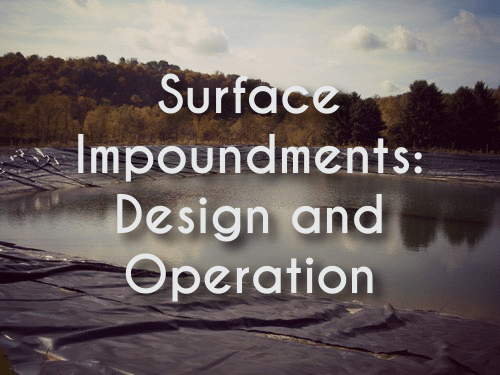
When the EPA was designing the cradle-to-grave system for managing hazardous wastes they developed nine different land disposal units. These units include landfill, surface impoundment, waste pile, injection well, land treatment facility, salt dome formation, salt bed formation, underground mine, and underground cave. Four of these nine unit types required additional technical standards set forth by the EPA. Today we will be covering the design and operating standards of one of those four, surface impoundments.
Surface impoundments are a lot like landfill cells in that, “both units are either a natural topographic depression, manmade excavation, or diked area formed primarily of earthen materials, such as soil.” Additionally, both may be lined with manmade materials. Their uses, however, are what make them so different. According to the EPA, “surface impoundments are generally used for temporary storage or treatment, whereas a landfill is an area designated for final waste disposal.” Because of this, the closure and post-closure standards are very different.
How are surface impoundments designed?
When the EPA began developing the design and operation standards for surface impoundments they operated with the goal of minimizing the formation and migration of leachate to the adjacent subsurface soil, groundwater, and surface water in mind.
According to the EPA, “these comprehensive technical requirements for surface impoundments are the minimum technological requirements (MTRs) mandated by RCRA. These sections require a double liner, a LCRS, and a leak detection system.” The MTRs are applicable to all new units, lateral expansions, and replacement units constructed or reused after July 29th of 1992.
First things first, we’ll talk about the double liner. This system includes, “a top liner to prevent migration of hazardous constituents into the liner and a composite bottom liner consisting of a synthetic geomembrane and three feet of compacted soil material.”
In addition to this liner system, the unit has to have a leachate collection and removal system (LCRS) which also serves as a leak detection system. According to the EPA, “The LCRS, along with the leak detection system drainage layers, must be designed with a bottom slope of at least one percent, be made of materials chemically resistant to the wastes placed in the unit, and be able to remove the liquids at a specified minimum rate. The LCRS itself must be designed to collect liquids in a sump and subsequently pump out those liquids. In addition to the performance and design requirements, the LCRS must be located between the liners immediately above the bottom composite liner, enabling the LCRS to collect the largest amount of leachate, while also representing the most efficient place to identify leaks.”
Making sure that material can’t leak back into the earth is not the only consideration that must be made, however. Surface impoundments also must be designed to prevent liquids from flowing over the top (called overtopping) and “ensure the structural integrity of any dikes.” The owner or operator must also develop a site-specific flow rate for leachate which is called the action leakage rate or ALR. This is used to indicate when a units system is not functioning as it should.
Because of the importance of these design regulations (and since none of the aforementioned technologies will work if the impoundment is not installed correctly or made of quality materials) the EPA requires a construction quality assurance (CQA) program to make sure that an impoundment meets all technical criteria. According to the EPA, “The CQA program requires a CQA plan that identifies how construction materials and their installation will be monitored and tested and how the results will be documented (§264.19). The CQA program is developed and implemented under the direction of a registered professional engineer, who must also certify that the CQA plan has been successfully carried out and that the unit meets all specifications before any waste is received.”
Quoted and EPA cited information (unless otherwise noted) for this blog post was gathered from the EPA document, “Introduction to Land Disposal Units.” As always, this blog post is not intended to be comprehensive and it is always best to check with the EPA and local government for full, up-to-date, rules and regulations.
More News From Heritage
-
3/7/25
Celebrating Our Team: Employee Appreciation Shoutouts
Learn about how we celebrated Employee Appreciation Day
-
3/6/25
Accelerating Action: Celebrating International Women’s Day
Learn about how we're celebrating International Women's Day
-
2/21/25
Heritage Announces East Liverpool, Ohio 2025 Environmental Grant Program
Learn about our East Liverpool Ohio grant opportunity!
-
2/18/25
Heritage Environmental Services Announces James (Shelby) Marlow as Chief Financial Officer
Heritage Environmental Services announced today that James (Shelby) Marlow will join the organization as Chief Financial Officer.
-
1/31/25
January Community Engagement Initiative: Home/Work Energy Reduction
Learn about our January community engagement initiative
-
1/29/25
Heritage Environmental Services Announces Chris Ebeling as Chief Commercial Officer
Heritage Environmental Services announced today that Chris Ebeling will join the organization as Chief Commercial Officer.
-
1/28/25
Heritage Environmental Services Addresses Industry Challenges with New State-of-the-Art Shredder
Heritage Environmental Services announced a new state-of-the-art shredding unit.
-
1/7/25
Navigating e-Manifest: What You Need to Know About Hazardous Waste Compliance
Learn about the e-Manifest Third Rule changes that begin January 22, 2025







